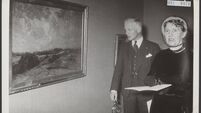Eat, drink... and then lose weight
CHRISTMAS is coming and the goose is getting fat. She’ll be in good company. Most of us will put on a kilogramme or two during the festival of gluttony. Feasts were important for survival long ago; as in Pharaoh’s dream, periods of plenty were followed by famines. Things were fairly Spartan even in Ireland. The national diet was simple and bland, subsistence fare.
Most food was produced locally; little was imported. Agriculture was at the mercy of wind and weather. Grain could be stored if rats and mice were kept at bay. Meat and fish might be salted, but, in a world without refrigeration, food had to be eaten before it deteriorated. The best way to conserve its energy and nutrients was to convert it into body fat.
People overindulged at Christmas and Easter but lived frugally for the rest of the year.
The annual festivals were not mere idle entertainment; they had a serious purpose. They built people up for the bad times. We are gluttons by nature. There were limits to consumption of course; in a world with few comforts, a person had to be fit.
The problem nowadays, for us in the affluent west, is that there are no famines to slim us down and we eat ourselves to death. As American presidential candidate Mike Huckabee put it: “We dig our graves with our knifes and forks”. Other creatures don’t behave like this.
When birds of prey were decimated by pesticides during the 1950s, great tits became heavier. A heavy bird is slower on the wing than a light one and easier prey to a sparrowhawk or a peregrine; small birds have to be weight-watchers. When the pesticides were banned, the predators returned and great tits become lighter again. Bird weights vary. A six-month old swan is as big as its parent but it might weight only 7kg or 8kg. It gets heavier with age; a well-heeled male in the prime of life could tip the scales at 14kg.
Obesity may be unknown among wild creatures, but animals have their feasts.
The annual hedgehog binge took place last month; the revellers are now curled up in their beds. The fat they lay down for hibernation is brown in colour and easily converted to body heat. Although most will have eaten enough to keep them ticking over until spring, the lighter ones will keep their fingers crossed, hoping for a mild winter. Hedgehogs lose about a third of their body weight in the annual sleepover but many don’t survive. The same is true of bats, dormice and Alpine marmots.
Laying on winter fat does not suit every lifestyle. There is a widespread misconception, for instance, that squirrels hibernate. To do so they would have to fatten up, not a good idea for an animal living up in the trees. The smaller branches won’t support the extra weight, so a squirrel must get by on stored nuts. Bears, living on the ground, don’t have to worry about their weight. They too fatten up for the winter sleep. Only pregnant polar bear females take to their beds but both male and female brown bears hibernate. Sizes vary: A big European brown, for example, might reach 300kg in the autumn but a male of the Alaskan race, known as the Kodiac, might be five times as heavy.
For big cats, feasts are moveable. A pride of lions, fattened after gorging on a kill, will sleep for days. Vultures are often the worst for wear through over-indulgence; some can’t even take off with their bellies full. So, bon appétit this Christmas; live it up by all means but remember to slim down afterwards.













